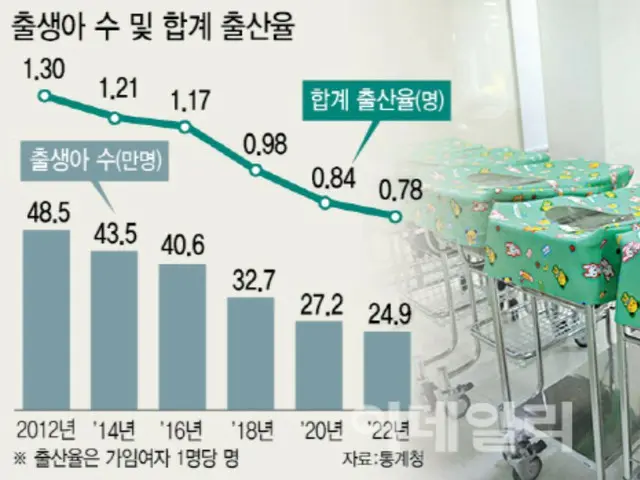The Statistics Agency will announce the "Population Trends for July 2023" on the 27th. This year, the number of children born continues to decrease compared to last year, and if this trend continues, the total birth rate (the number of children expected to be born per woman in her lifetime)
There are concerns that the expected number of children will fall to the 0.7 level. According to the "June Population Trends" released last month, the total birth rate in the second quarter of this year (April to June) was the same as the same period last year (0.
The total number of deaths was 0.7, a decrease of 0.05 compared to 75 people. This is the lowest number on record on a second quarter basis, and the lowest on record for any quarter in 2022 (September to January 2022).
It was at the same level as in February). By month, the number of children born has continued to decline since December 2015, with the exception of September 2022 (0.1%). The number of babies born in June was the lowest ever for the same month.
A total of 18,615 people did not. Until the new year, more people will be getting married, which had been postponed due to the spread of the COVID-19 virus, and there are expectations that the birth rate will rise this year.
Ta. This is because the number of marriages is considered a leading indicator of the birth rate. However, as of the first half of this year (January to June), no correlation has been made clear. The number of marriages in South Korea is 9.2% higher than a year ago.
The number of cases increased by 101,704, marking the highest level since statistics began being collected in 1982. Considering that the birth rate usually decreases towards the end of the year, this year's total annual birth rate is
There is a high possibility that the number will fall further, and it is thought that there is a possibility that the number will fall below 0.6 for the first time. In 2022, South Korea's total birth rate will be 0.78 children, which is the highest among Organization for Economic Co-operation and Development (OECD) member countries.
South Korea was the only country with a total birth rate of less than one child. The number of children born was 249,000, half of what it was 20 years ago. South Korea is preparing for a “super-aging society” in which more than 20% of the population is 65 years of age or older.
Materials suggesting the direction in which Japan should move will also be made public. On the 25th, the Korea Development Institute (KDI), a national policy research institute, will announce ``Poverty among the Elderly and Policy Directions Diagnosed by Income and Assets.'' Sara
The next day, on the 26th, the National Statistics Agency will release the 2023 Elderly Statistics. The statistics on the elderly, which have been released since 2003 in conjunction with Old People's Day (October 2), are based on the elderly population and aging population.
It reflects factors such as the speed of economic growth, assets and liabilities, the state of economic activity, income distribution, and changes in consciousness. According to the 2022 Elderly Statistics, the percentage of people aged 65 to 79 who hope to work in the future is 54.
It reached 7%. This is a 12.1% increase from 10 years ago in 2012 (42.6%). The most common reason elderly people want to work is "for living expenses" at 53.3%, followed by "to work".
"For fun" followed at 37.3%. Although the relative poverty rate (below 50% of median income) among the retirement age group fell from 47.7% in 2013 to 40.4% in 2020, it remains
It ranked first among D member countries. There are growing voices warning that South Korea's economic growth will slow due to a decline in South Korea's population due to a declining birthrate and aging population. In May, the English daily Financial Times published the ``Standard &
The world's three largest credit rating companies, including Poor's (S&P), Moody's, and Fitch, view aging as a factor that will have a negative impact on the credit ratings of major countries.
There is a history of naming Japan as the country facing the worst credit rating around the year. Fitch, an international credit rating agency, said, ``If the South Korean government develops policies to encourage the immigration of young foreign workers,
Ultimately, this will improve productivity and help balance old-age support costs."
2023/09/24 06:52 KST
Copyrights(C) Edaily wowkorea.jp 107

